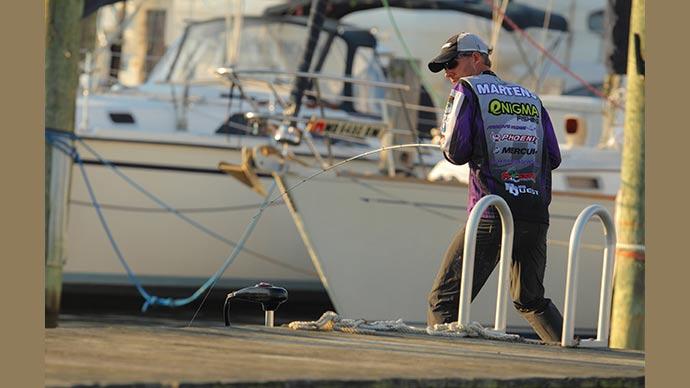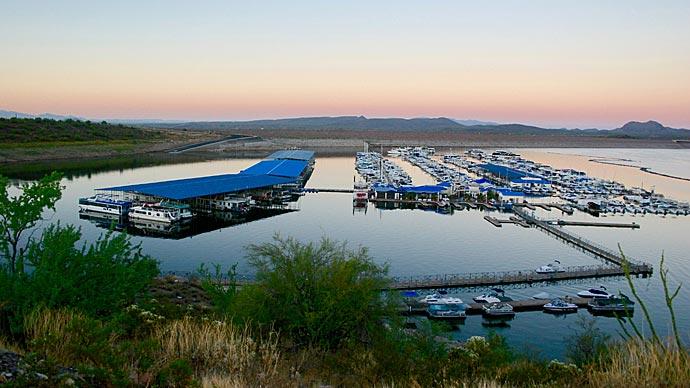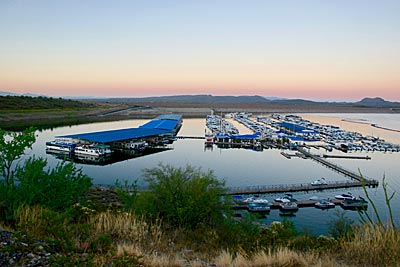
There are just about as many kinds of marinas as there are lakes – when I was talking to Gary Dobyns about marinas, he immediately thought of the marinas in the Delta and had that picture in his mind until I mentioned the marinas we have in Arizona. We both suddenly realized that you could almost write an entire article on the different kinds of marinas a bass fisherman might encounter. For instance, in our big desert impoundments, a marina is generally just separated from the main lake by a huge breakwater made of giant tires chained or roped together. In the Delta, it might be part of an entire arm of the lake, and you would have to pass through with no wake until the marina ends and you’re in the arm again.
There are river marinas that are built along the shore, desert marinas, tidal marinas, and even marinas that are in man-made sloughs. Alabama angler Eddie Johns told me about one dug-out next to the main channel, with just a narrow entrance. Some marinas have weeds; some are dead-ends, some are pass-throughs. You can find marinas with water a hundred feet deep or more in Arizona. But all marinas have certain things in common: piers, docks, slips, and many boats. There are plenty of structures you need to get underneath to fish and a pretty vertical structure. They are also lighted at night, which is a real bonus for a night fisherman.
Gary Dobyns (owner of Dobyns Rods) says that fishing marinas can be tricky, but they hold much fish. Fishing around those boat docks and especially slips requires definite casting skills. He particularly likes marinas during the spawn. An extensive marina like the ones at the Delta are giant pockets, and because of the current outside, the fish are drawn in to spawn in the relatively stable water. He’s seen them spawn on cavitation plates of motors and even cables. At Lake Pleasant, we saw beds on angle iron no more than 3 inches wide in the marina. Summer is great, too – plenty of shade to hold them. There are always fish in the marina, he says.
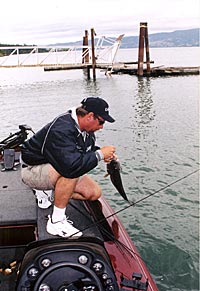
Dobyns does a ton of flipping in marinas – on pilings, docks, etc. The best lures are weightless Yamamoto Senkos – just let them float down along the pilings. You can’t fish a Senko wrong, says Gary. It’s going to get a bite no matter what you do. He also pitches baits underneath platforms and skips stuff under pontoon boats and docks. “If you’re going to fish marinas, you need to know how to skip a bait,” he says. Breakwaters like those at Powell, Mead, Pleasant, and even Bartlett Lake also provide a lot of shade and hold lots of fish. One summer, we tossed Westy Worms to the tires at Pleasant, and my buddy hooked a nice little bass. As he reeled it to the boat, suddenly a huge bass shot out from under the tires and grabbed it – scraped a bunch of scales off and gave us a thrill. Those breakwaters are dynamite IF you’re allowed to fish them.
Caveats
Many tournaments cite marinas as off-limits, including the breakwaters. Also, many marinas ban fishermen from fishing slips. If you’re fishing in a tournament, ensure you know the rules before going in, and watch for signs saying “no fishing.”
Many marinas welcome anglers. Eddie Johns will go into the store in a marina and buy a soda, then look around to see if there are any fliers advertising tournaments. If there are, you can be assured the marina is fisherman-friendly. But he’ll also chat with the cashier and ask about fishing in the marina, especially about any recent tournaments.
Recycled Fish
The fish are generally released at or near the ramp when tournaments are held at a marina. These “recycled” fish stay in the marina for much longer than most people think, says Johns. In the winter, he takes cedars out, weights them, and drops them about twenty feet off the end of the ramp. Before you do this, check to make sure it’s legal where you are. After getting their fish weighed, people usually walk down the ramp and let the fish go there. They’ll follow that concrete out, hit those cedars, and hang out for a while. Eddie says that he’s caught a lot of fish off those cedars. He says the fish will sit on that stuff even with a lot of boat traffic.
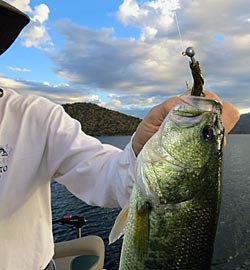
Eddie likes to fish piers during the hottest part of the day, and he uses a variety of lures to get under them. Remember the old Flying Lure? Eddie still has them, and they hurry right under the pier – no skipping required. Fish them on spinning gear with plenty of slack. Another way to get a lure away from you is to rig it Texas with no weight, then put a nail weight in the far end. The nail will pull them away and go right under the pier. Tube baits are great for around piers, especially with the addition of a little Alka Seltzer. Eddie uses an awl to put a few holes in the bait, pours in some ground-up Alka Seltzer, then stuffs cotton in the open end. The slits made by the awl let just enough water in (and fizz out) to make the bait attractive. He says you need to flip these baits – if you cast them, the cotton will come out. The cotton will eventually get saturated, and you’ll have to re-pack. You can use a piece of packing peanut or a pre-cut round of cork board instead of cotton, but those take a while to rig. If he knows he’ll be throwing a lot of tubes, he’ll rig a bunch up the night before. Hold it to your ear every few casts and see if it’s still fizzing. Those bubbles and that fizz draw the bass from a distance. By the way, this is also a dynamite lure for bed fishing.
Another way to get a lure under the docks and piers is to use a crankbait. You can cover a marina pretty quickly with a plug, and if you bend the eye off to the side, the bait will run at an angle and get under things. This is especially good for floating piers.
Eddie says the narrower the entry to the marina, the better. It takes the fish a while to find their way out of those, even if water is moving in the channel. Sometimes the channel is built using riprap, which is excellent for holding craws, which means the bass will be there too. Pitch a jig or craw to that stuff and bounce it down. Johns breaks a marina into three sections: back, middle, and mouth. The time of year dictates where he fishes. In spring, the back and under piers with wooden slats are best. The shallow water warms up quickly, especially if the marina is on the north or west bank of the lake. That makes it great in winter or spring.
Marinas are also excellent places for figuring out what the fish want. Eddie will put out every color of Creme lure he has– spread them all on the deck. He’ll fish each bait for fifteen or twenty minutes in the marina. The marina, being a high percentage area, is the perfect place for this. Once he catches two or three fish of a certain color, he knows the “what.” And once you know the “what,” the “where” is much easier to figure out, Eddie says.
Fish or Pass?
First, Eddie checks to see if the marina hosts many tournaments. Then he looks at the entry. Is it wide or narrow? He prefers the narrow ones, but wide ones with enormous breakwaters can be good too. Are the piers floating, or are there a lot of cables and posts? He says if there is a campground, he’ll always give it a pass – those fish are subjected to constant harassment from shore fishermen. Does the marina have constant heavy traffic? There are a lot of factors to consider, and you have to balance them out. You can also watch other people who are fishing in the marina. A pair of binoculars will let you see what they are doing and the kind of fish they are catching. (Don’t scoff – this is common on almost every lake in the West). Take every legal advantage that you can, Eddie says. He'll stay there all day if he finds a just right marina. You can dissect a marina just as you’d dissect an entire lake and end up with a specific pattern that will let you put together an extremely effective milk run.
If a marina allows fishing, by all means, give it a try. All that structure and cover provide ample habitat for bass. For night fishing, the lighted marina is a great place to fish, especially if you are new to night fishing and a bit nervous about going out on the main lake on a moonless night. Although breakwaters, tires, and marinas are sometimes off limits in tournaments, they are dynamite places for fun fishing. Next time you launch, don’t just motor through the marina and take off. Spend some time there – you may be very pleasantly surprised.



